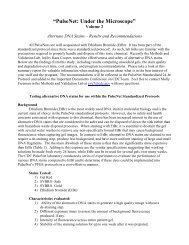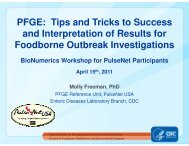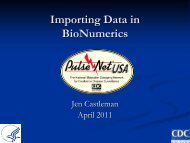Part 1 - PulseNet International
Part 1 - PulseNet International
Part 1 - PulseNet International
Create successful ePaper yourself
Turn your PDF publications into a flip-book with our unique Google optimized e-Paper software.
STANDARD OPERATING PROCEDURE FOR WRITING STANDARD OPERATING<br />
PROCEDURES<br />
CODE: PNG01<br />
Effective Date:<br />
05 09 05<br />
26. <strong>PulseNet</strong> laboratory protocols: Protocols or standard operating procedures followed by all<br />
laboratories participating in the <strong>PulseNet</strong> program in order to submit DNA fingerprint patterns for<br />
inclusion in the National Database<br />
27. Troubleshoot: To investigate a problem and come up with solutions<br />
28. Surge capacity: Ability to provide additional testing when workload exceeds existing capacity<br />
29. Bundle file: A file with a .bdl extension that is produced in BioNumerics and contains the analysis<br />
of at least one lane of a gel image and may include specified isolate demographic information<br />
30. Foodborne disease epidemiologist: An individual who studies and/or investigates the transmission<br />
and control of foodborne diseases<br />
31. Outbreak: A rise in disease rates as a result of an association or exposure to a specific vehicle<br />
32. Proficiency testing: An annual assessment of the quality of the work being performed in <strong>PulseNet</strong><br />
participating laboratories. For each pathogen, proficiency testing includes two parts – a “TIFF sent by<br />
CDC” and a “TIFF generated by the participating laboratory (i.e., in-house TIFF)”<br />
33. Proficiency testing packet: A package sent to the <strong>PulseNet</strong> participant with the results of his/her PT<br />
evaluation. Includes a hard copy of the cover letter, report, in-house TIFF, and submission e-mail<br />
34. TIFF sent by CDC: This is a part of the proficiency testing program where all laboratories analyze<br />
the same TIFF sent to them by CDC<br />
35. TIFF generated by the participating laboratory, also called the “in-house TIFF”: A part of the<br />
proficiency testing program where laboratories run a gel and produce a TIFF of the gel that contains<br />
the Salmonella Braenderup H9812 standards and the proficiency testing strain restricted with the<br />
primary and secondary enzymes. The TIFF is analyzed and submitted to the on-line database<br />
36. Proficiency Testing survey: An annual survey consists of two rounds of testing, a fall round and a<br />
spring round<br />
37. Comparison list: A list of analyzed lanes from comparison TIFFs that is saved in BioNumerics and<br />
used to compare to the analysis of the submitted TIFF by the certification file evaluator and the<br />
analysis of the submitter in the certification bundle file<br />
38. Gel certified: Formerly “TIFF certified.” An individual or laboratory that is certified in laboratory<br />
methods for PFGE and image acquisition<br />
39. Analysis certified: An individual who is certified in BioNumerics gel analysis<br />
40. Certification files: TIFF and/or bundle files submitted by <strong>PulseNet</strong> participants for certification<br />
evaluation<br />
41. Certification file evaluator: An individual who evaluates certification files<br />
42. TIFF quality: The grading of the appearance and ease of analysis of a TIFF according to the<br />
<strong>PulseNet</strong> TIFF Grading Guidelines. This is a main component of the evaluation of a TIFF submitted<br />
for certification<br />
43. Gel analysis assessment: The grading of the whole analysis of a TIFF, including gel and lane<br />
definition, normalization, and band marking, according to the <strong>PulseNet</strong> Gel Analysis Guidelines. This<br />
is a main component of the evaluation of a bundle file submitted for certification<br />
44. Certification file reviewer: An individual who reviews and signs off on the certification reports<br />
submitted by the certification file evaluator<br />
45. Comparison TIFFs: One or more TIFFs run by CDC for a specific pathogen for use in comparing<br />
PFGE patterns and band resolution against submitted certification TIFFs. Comparison TIFFs can also<br />
be a group of certification TIFFs submitted by several laboratories to monitor PFGE patterns and<br />
band resolution over several submitting laboratories. The latter is most easily accomplished through a<br />
saved list in BioNumerics<br />
46. APHL: Association of Public Health Laboratories<br />
47. Host lab: Term used to describe laboratory hosting a training course<br />
48. OHS: Office of Health and Safety<br />
VERSION: REPLACED BY: AUTHORIZED BY:<br />
Page 4 of 5










